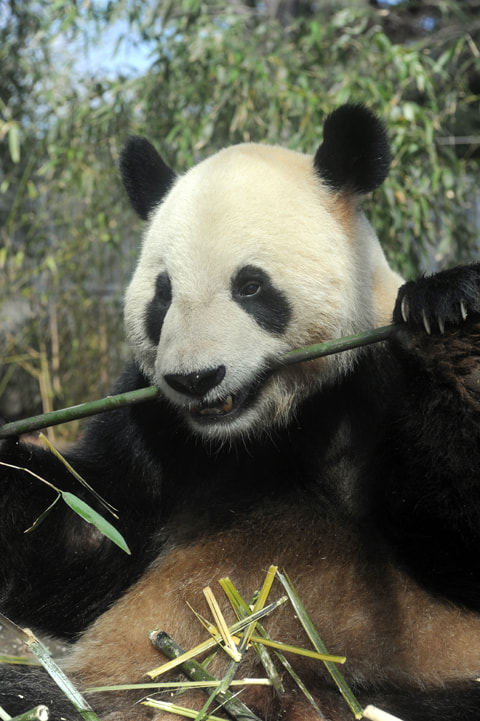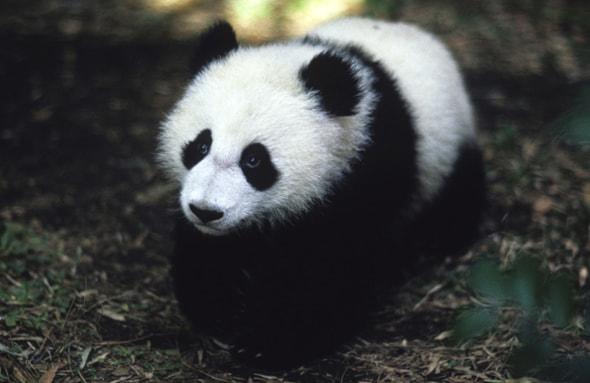
Tong Tong, a daughter between Fei Fei and Huan Huan, which was shown to the public (1986)
Yu Yu, a brother of Tong Tong, was born in 1988, but was given to the Beijing Zoo in exchange for Ling Ling in order to avoid inbreeding.
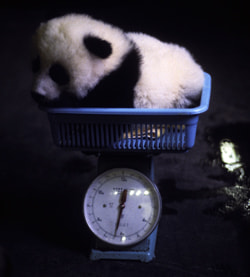
Measuring of Tong Tong's weight
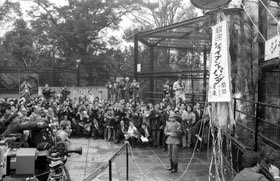
The unveiling ceremony of Kang Kang and Lang Lang in 1972
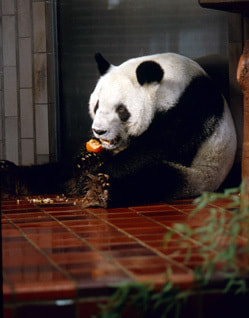
Everyday feed for giant pandas is the most expensive. It is followed by Asiatic elephants, okapis and black rhinoceroses. Giant pandas' feed is expensive due to the price of bamboos. Another relatively expensive feed is fresh horse mackerels that are eaten by eared seals. Eared seals only eat fresh horse mackerels, but gorillas eat 20 kinds of feed, including vegetables, fruits, dairy products and nuts. The followings are the top 10 animals that eat expensive feed.
1) Giant panda
2) Asiatic elephant
3) Okapi
4) Black rhinoceros
5) Giraffe
6) Brazilian tapir
7) Hokkaido bear
8) Hippopotamus
9) Polar bear
10) Sumatran tiger
Giant pandas were presented to Japan in 1972 in commemoration of the normalization of bilateral Sino-Japanese relations. It was decided that the Ueno Zoo would accept Kang Kang, a two-year-old male panda, and Lang Lang, a four-year-old female. At first, the two pandas were temporarily kept at a tiger house in the zoo, but they moved to a new glass-walled panda house in 1973. Kang Kang and Lang Lang were very popular among visitors. When they were shown to the public on November 5, the next day of a commemorative ceremony, visitors stood in a two-kilometer queue waiting to see the pandas. The number of visitors reached 5.01 million in 1975 and 6 to 7 million until 1979. However, Lang Lang died in September 1979. Although Huan Huan, a new mate for Kang Kang, came to the zoo in 1980, Kang Kang died suddenly in June, the same year.
Successive giant pandas in the Ueno Zoo are Kang Kang, Lang Lang, Huan Huan, Fei Fei, Tong Tong, Yu Yu, Shuan Shuan, Ling Ling, and Ri Ri, a male, and Shin Shin, a female, both of which were born at the Wolong conservation and research center for giant pandas in China and came to the zoo in 2011. (continued in the lower column)
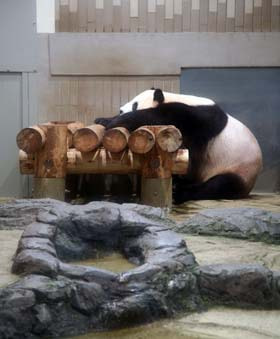
Ri Ri lying down comfortably
It was a very hot summer day, so Ri Ri stayed in a glass-walled, air-conditioned room. The room is fully air-conditioned and has a floor heating system so that it is constantly kept at approximately 24 degrees Celsius.
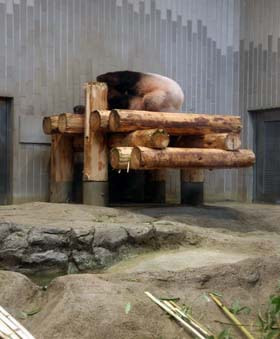
Shin Shin sleeping with her back toward this side
There are a playground and a glass-walled room in the panda house, surrounded by a bamboo grove that is used as emergency provisions. The house was made in the image of the environment in China's Sichuan Province, their birthplace.
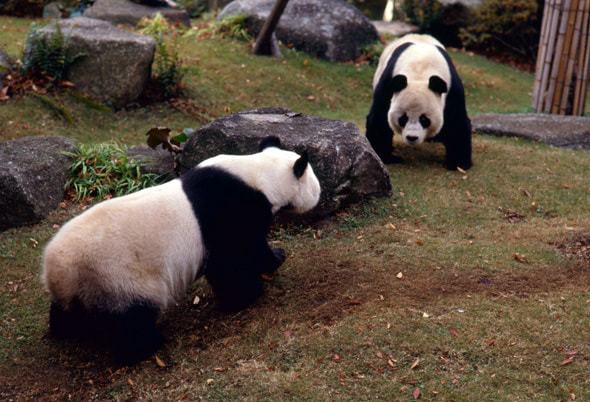
Fei Fei, a male (back), and Huan Huan, a femal
Huan Huan gave birth to three cubs, Chu Chu, Tong Tong and Yu Yu, and reared them. Chu Chu, the first cub, was the first panda born in Japan, but died in 43 hours.
The Ueno Zoo succeeded to artificially breed three giant pandas, and two of them grew up. While one of the roles of the zoo is to exhibit wild animals, it also strives to preserve wild animals and breed precious animals, using handling and feeding techniques and health care method which have been accumulated over the years.
The International Panda Conference, sponsored by the San Diego Zoo in the United States, was held in 2000 and attended by delegates of the United States, Spain, Germany, Mexico and Japan, in which communal breeding of pandas was planned. As a result, the Ueno Zoo's Ling Ling went to Chapultepec Zoo in Mexico in 2001 in order to communally breed pandas. Ling Ling had traveled back and forth between Japan and Mexico three times to carry out this breeding program, so he was a panda which had most frequently got into planes. Through the good offices of the San Diego Zoo which mediated the breeding program, the Ueno Zoo had Kimbia, an okapi, on loan in 2001 to make up for the absence Ling Ling. Also, Shuan Shuan, a female panda, came to the Ueno Zoo from Chapultepec Zoo in Mexico, and stayed in the Ueno Zoo for two years, but this breeding program was not really successful.
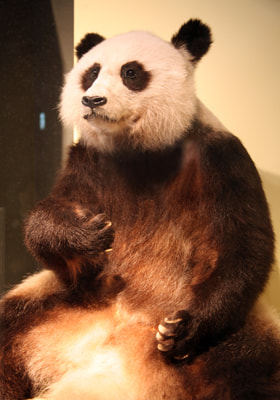
Huan Huan (stuffed specimen / owned by the National Museum of Nature and Science)
After animals kept in the Ueno Zoo die, they are preserved as stuffed or skeletal specimens in the National Museum of Nature and Science and other facilities for display and educational purposes. The stuffed specimen of Huan Huan is displayed on the first floor of the Global Gallery, National Museum of Nature and Science.
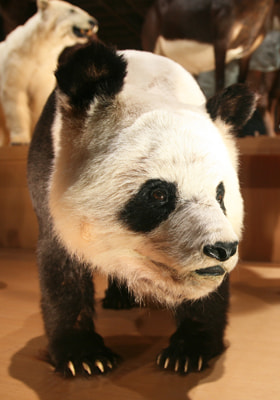
It is displayed on the third floor of the Global Gallery, National Museum of Nature and Science.
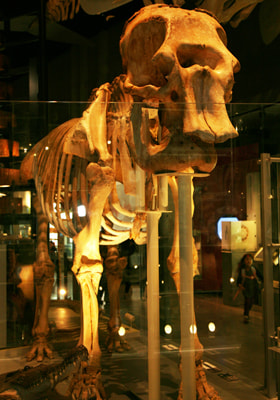
Indira, an Asiatic elephant (skeletal specimen / owned by the National Museum of Nature and Science)
Indira, presented by Indian Prime Minister Nehru in 1949, had a long life and was popular among visitors to the Ueno Zoo. She lived until 1983. Her skeletal specimen is displayed on the first floor of the Global Gallery, National Museum of Nature and Science.
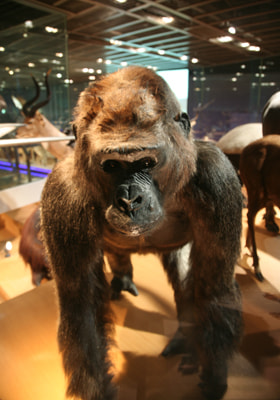
Bul Bul, a western lowland gorilla native to Cameroon, came to the Ueno Zoo in 1957, and died in 1997 at the estimated age of 44. The average age of gorillas is about 40, so he lived for a very long time. His stuffed specimen is displayed on the third floor of the Global Gallery, National Museum of Nature and Science.
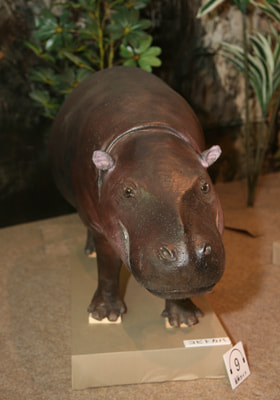
Tabo, a pygmy hippopotamus (stuffed specimen / owned by the National Museum of Nature and Science)
Tabo, a pygmy hippopotamus less than one tenth of the size of ordinary hippopotamuses, stayed in the Ueno Zoo from 1972 to 2001, and then moved to the Wakayama Adventure World and lived until 2005. He came to the Ueno Zoo at the estimated age of 2, so he had a very long life.
(quoted from the "Kahaku Specimen Zoo" exhibition held at the National Museum of Nature and Science (from April to May 2011) in commemoration of the coming of pandas)
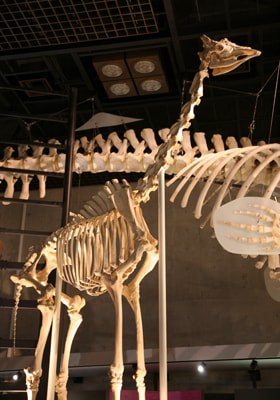
This is a skeletal specimen of Takao, a giraffe, which came from Kenya at a time when large animals were still rare in Japan. He died at the old age of 31. It is displayed on the first floor of the Global Gallery, National Museum of Nature and Science.
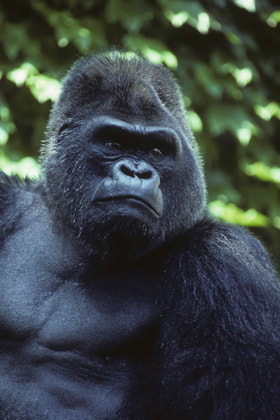
The late Bul Bul that was honored as an animal of merit by the Japan Society for the Prevention of Cruelty to Animals
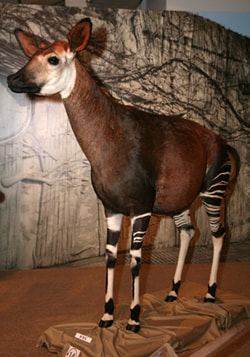
The okapi is a giraffid artiodactyl mammal living in forests in Congo. It bears striped markings at its legs, which help it hide in shrubs. Kimbia, an okapi, came from the San Diego Wild Animal Park in 2001, and lived until 2008. (quoted from the "Kahaku Specimen Zoo" exhibition held at the National Museum of Nature and Science (from April to May 2011) in commemoration of the coming of pandas)

Measuring of Tong Tong's weight

The unveiling ceremony of Kang Kang and Lang Lang in 1972

Everyday feed for giant pandas is the most expensive. It is followed by Asiatic elephants, okapis and black rhinoceroses. Giant pandas' feed is expensive due to the price of bamboos. Another relatively expensive feed is fresh horse mackerels that are eaten by eared seals. Eared seals only eat fresh horse mackerels, but gorillas eat 20 kinds of feed, including vegetables, fruits, dairy products and nuts. The followings are the top 10 animals that eat expensive feed.
1) Giant panda
2) Asiatic elephant
3) Okapi
4) Black rhinoceros
5) Giraffe
6) Brazilian tapir
7) Hokkaido bear
8) Hippopotamus
9) Polar bear
10) Sumatran tiger

The late Bul Bul that was honored as an animal of merit by the Japan Society for the Prevention of Cruelty to Animals

Kimbia, an okapi (stuffed specimen / owned by the National Museum of Nature and Science)
The okapi is a giraffid artiodactyl mammal living in forests in Congo. It bears striped markings at its legs, which help it hide in shrubs. Kimbia, an okapi, came from the San Diego Wild Animal Park in 2001, and lived until 2008. (quoted from the "Kahaku Specimen Zoo" exhibition held at the National Museum of Nature and Science (from April to May 2011) in commemoration of the coming of pandas)

















